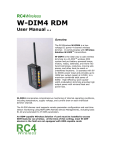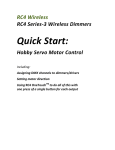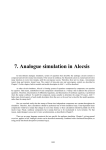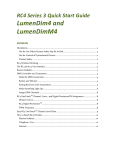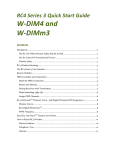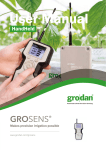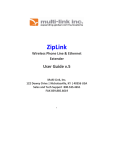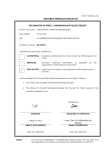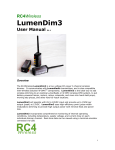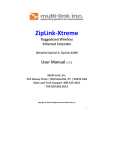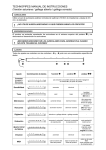Download RC4Magic Series 2 R3 System User Manual
Transcript
RC4Magic Series 2 R3 Wireless DMX and Wireless Dimming System DMXioR3 Data Transceiver DMX2dimR3 2-Channel Receiver/Dimmer DMX4dimR3 4-Channel Receiver/Dimmer DMX4dim-500R3 fanless 4-Channel High Power Receiver/Dimmer System User Manual All RC4Magic devices are warranted for life. If it stops working, and you have not misused or abused it, we fix. For free. Forever. Details on page 30. 1 RC4Magic Series 2 R3 User Manual – Table of Contents Disclaimers ............................................................................................................... 4 Not for Use Where Human Safety May Be At Risk .................................................. 4 Not for Control of Pyrotechnical Devices ................................................................. 4 Product Safety ........................................................................................................ 4 Statements of RF Conformity .................................................................................. 4 United States (FCC) ................................................................................................ 4 Canada (IC) ............................................................................................................ 4 Japan ...................................................................................................................... 4 Europe (ETSI) ......................................................................................................... 4 Other Countries and Jurisdictions ........................................................................... 4 RC4Magic Quick Start – It’s Easy! ........................................................................... 5 DMX Transmitter ..................................................................................................... 5 DMX Receiver ......................................................................................................... 5 Identifying Transmitters and Receivers ................................................................... 5 Wireless Dimming ................................................................................................... 5 RC4Magic – An Overview ......................................................................................... 6 DMX Cable Replacement / DMX Distribution .......................................................... 6 Wireless Low-Voltage Dimming............................................................................... 6 System ID Numbers: Ultimate Data Security ........................................................... 6 Power-Up Sequence and Radio Channel Assignments ........................................... 7 Advanced Settings .................................................................................................. 8 DMXio R3 User Interface .......................................................................................... 8 LEDs at Power Up .................................................................................................. 8 LEDs in Running Mode ........................................................................................... 9 LEDs in Edit Mode ................................................................................................ 11 Recessed Buttons ................................................................................................. 11 Buttons at Power Up ............................................................................................. 12 Buttons in Running Mode ...................................................................................... 12 DMXioR3 Transmitter Setup .................................................................................. 13 DMXio Receiver Setup............................................................................................ 14 DMX2dimR3 Receiver-Dimmer Setup .................................................................... 15 DMX4dim Receiver-Dimmer Setup ........................................................................ 18 DMX4dim-500R3 fanless High Power Receiver-Dimmer Setup ........................... 21 2 Dimmer Resolution and Curves............................................................................. 22 Dimmer Resolution ............................................................................................... 22 Dimmer Curves ..................................................................................................... 22 Optimizing Radio Performance.............................................................................. 23 How do I… ............................................................................................................... 24 Troubleshooting and Frequently Asked Questions ............................................. 24 General ................................................................................................................. 24 Mounting and Positioning ...................................................................................... 26 Dimmer Problems ................................................................................................. 26 RC4Magic Series 2 Specifications ......................................................................... 28 RC4Magic RF Technology .................................................................................... 28 RC4Magic DMX Protocol Compliance ................................................................... 28 DMXioR3 .............................................................................................................. 28 DMX2dimR3 Receiver-Dimmer ............................................................................. 28 DMX4dimR3 Receiver-Dimmer ............................................................................. 29 DMX4dim-500R3 fanless Receiver-Dimmer ......................................................... 29 Warranty Policy ...................................................................................................... 30 Seven-Day Easy Return ........................................................................................ 30 Thirty-Day Replacement or Fast-Turn Service Guarantee ....... Error! Bookmark not defined. One Year Parts and Labor General Guarantee ........ Error! Bookmark not defined. Out of Warranty Service Policy................................. Error! Bookmark not defined. Disclaimers We Must Make ................................................................................... 30 How to Reach RC4 Wireless .................................................................................. 31 Physical Address .................................................................................................. 31 Telephone / Fax .................................................................................................... 31 Internet ................................................................................................................. 31 3 Disclaimers WIRING AND INSTALLATION OF BATTERIES, DIMMERS, AND LOADS MUST BE IN ACCORDANCE WITH APPLICABLE LOCAL AND NATIONAL ELECTRICAL CODES. RC4 Wireless devices and equipment are operated at the user’s own risk and RC4 Wireless accepts no liability, either direct or consequential, as a result of using this equipment. Not for Use Where Human Safety May Be At Risk RC4 Wireless accepts no liability for direct, indirect, or consequential damages resulting from the use of any RC4 Wireless product or group of products. RC4 Wireless does not guarantee the suitability of any product for any purpose; user assumes all risk. RC4 dimmers must be used strictly in accordance with manufacturer's instructions and cannot be used for unsupervised operation. RC4 Wireless products must be installed and operated only by qualified technicians, as outlined in the manufacturer's documentation, and should be inspected and tested on a regular basis to ensure proper and safe operation. Not for Control of Pyrotechnical Devices RC4 Wireless products should not be used to control pyrotechnics of any kind. A brief output surge on dimmer outputs during power-up could trigger these devices. RC4 Wireless accepts no liability if RC4 equipment is used for this or any other purpose. Product Safety RC4 receiver/dimmers are capable of controlling very large currents at up to 30VDC (typically 12V). Dimmers should not be allowed to operate at dangerous temperatures. Appropriately sized wire and connectors must be used, along with suitable ventilation and external fuses rated for the load being operated. Additional information is provided in this manual, but this manual is not intended to be a comprehensive electrical safety guide, Statements of RF Conformity United States (FCC) RC4Magic Series 2 devices contain XBeePro radios, FCC ID OUR-XBEEPRO, and comply with Part 15 of the FCC Rules. Operation is subject to the following two conditions: (i.) these devices may not cause harmful interference and (ii.) these devices must accept any interference received, including interference that may cause undesired operation. Canada (IC) RC4Magic Series 2 devices contain XBeePro radios, IC: 4214A-XBEEPRO. Japan RC4Magic Series 2 devices contain XBeePro radios, ID: 005NYCA0378. Europe (ETSI) XBeePro radios used in RC4Magic Series 2 devices have been certified for use in most European countries. Norway prohibits operation near Ny-Alesund in Svalbard. Other restrictions may apply. For additional information, please contact RC4 Wireless. Other Countries and Jurisdictions XBeePro radios used in RC4Magic Series 2 devices have also been issued Declarations of RF Conformity for Australia/New Zealand, and Korea. For additional information, please contact RC4 Wireless. 4 RC4Magic Quick Start – It’s Easy! RC4Magic Series 2 is truly Plug-n-Play – you can start using it right away. DMX Transmitter If your system has just one DMXio module, it will be factory configured as a transmitter. If you have multiple DMXio modules, only one is configured as a transmitter, the rest are configured as receivers. A temporary label has been provided to identify the transmitter. Connect a supplied wall-transformer power supply to your DMXio transmitter. Plug in a DMX data source and see that the dmx/RFc LED comes on. That’s it – you’re on the air. DMX Receiver Connect a supplied wall-transformer power supply to a DMXio receiver. It can take up to 15 seconds for the receiver to connect with the transmitter. When the RF data LED starts blinking and shimmering, you have DMX data coming out. You now have a 200+ foot wireless DMX link. Identifying Transmitters and Receivers If you’ve lost track of which DMXio is your transmitter, watch the LEDs during power-up. An LED chase from left to right – “signal going out” – indicates a transmitter. A chase from right to left – “signal coming in” – indicates a receiver. Wireless Dimming DMX2dim, DMX4dim, and DMX4dim-500 receiver-dimmers are complete standalone devices. New DMX2dim units are pre-assigned to DMX channels 1 and 2. DMX4dim units (both sizes) are pre-assigned to DMX channels 1, 2, 3, and 4. (It’s easy to change channel and dimmer curve assignments, as described later in this manual.) Using a small screwdriver, connect a power supply (usually a 12V battery) to the +/-DC IN screw terminals. Connect a load (usually an MR16 or MR11 12V lamp) to the DimA+/- terminals. After power-up, it can take up to 15 seconds for the receiver to connect with the transmitter. Fade DMX channel 1 up and down on the DMX controller connected to your DMXio transmitter. See your lamp dim up and down. You now have a wireless DMX-controlled lamp. Now it’s time to read through this manual to learn how to set dimmer channels, change system IDs, interpret the LEDs, and more. Thank you for choosing RC4Magic Series 2! 5 RC4Magic – An Overview DMX Cable Replacement / DMX Distribution The heart of RC4Magic Series 2 (RC4M-S2) is the DMXio module. (This manual refers specifically to the DMXioR3, which provides several features not available in earlier versions.) A DMXio can act as a wireless transmitter or receiver, and any number of receivers can be used in a system. A pair of DMXio units configured as transmitter and receiver replaces a standard DMX cable. RC4Magic modules work reliably to distances beyond 200 feet within most theatres and performance spaces. Any number of receivers can be used in an RC4Magic system, taking the place of splitters and distribution boxes, providing superior electrical isolation along with uncluttered convenience. Configured as a transmitter, the DMXio encodes and encrypts the incoming DMX universe, and broadcasts it using Direct Sequence Spread Spectrum (DSSS) digital radio. Unlike wired DMX, the broadcast signal includes error checking and correction codes, and is not affected by minor interruptions and interference. Incoming DMX channels are broadcast with appropriate speed, redundancy and accuracy; additional bandwidth is dynamically allocated to channels that are changing. This allows RC4Magic to use less radio bandwidth than competing systems while still delivering excellent DMX data performance. As a receiver, the DMXio decodes the rf signal from the associated transmitter, rebuilds the DMX universe, and generates a DMX signal with the same channels and packet timing as the original input. DMX in and out are compliant with the USITT DMX512/1990 standard. RC4Magic Series 2 does not transmit DMX messages with start codes other than zero. Thus, it can only be used for dimmer data. It will not work with non-zero packets carrying proprietary data or RDM packets. Wireless Low-Voltage Dimming The DMX2dim, DMX4dim, and DMX4dim-500 receiver-dimmers decode the rf signal from the DMXio transmitter and send user-selected DMX channel levels to built-in low-voltage dimmers. In addition to DMX channel, each dimmer can be assigned a linear, inverse square-law (ISL), or non-dim power curve. Any number and combination of RC4Magic Series 2 receiver-dimmers can be used in a system. RC4 System ID Numbers: Ultimate Data Security A system ID is a unique code, similar to a password or encryption key. When multiple RC4Magic Series 2 devices are configured with the same ID, they form a Private Area Network 6 (PAN). Other devices on other IDs can form their own PANs, and up to 15 independent PANs can operate in the same vicinity (defined by the range of the rf signal, typically 200 to 300 feet). Every RC4Magic user is initially assigned 3 unique private system ID codes and more can be assigned if needed. No other user in the world has the same unique codes you have. RC4Magic ID codes are managed by RC4 Wireless and authorized representatives through a worldwide online database system. No other wireless DMX system in the world – at any cost – provides this level of data security. Each of your RC4Magic Series 2 devices is programmed with 3 unique private ID codes that belong to you, plus a public ID (PAN ID 999). Your IDs are labelled on the outside of each unit, along with the device serial number. When ordering additional devices for an existing RC4Magic Series 2 system, you specify the ID numbers to be installed, which can be any combination of IDs previously assigned to you, and/or new IDs. To ensure the reliability and security of all RC4Magic Series 2 systems for all users, every new system for a new user is assigned its own set of new private IDs. In the rare case where multiple RC4 Magic Series 2 users need to share or pool their equipment, the common public ID can be used. Power-Up Sequence and Radio Channel Assignments When an RC4Magic Series 2 DMXio transmitter first powers up, it scans the 2.4Ghz radio band, which is quite large and supports many radio channels, looking for an area with the least traffic and lowest rf power levels. It then sets itself to operate on that frequency and begins transmitting DMX packets encoded with a specific system ID number. When this power-up process is complete, the RF data LED blinks rapidly or shimmers indicating data being sent. When a DMXio receiver or DMX2dim/4dim receiver-dimmer powers up, it scans the 2.4GHz band looking for signals from a DMXio transmitter on the selected ID number. When the PAN connection is established, the RF Con LED (on a receiver-dimmer) or dmx/RFc LED (on a DMXioR3) will blink steadily. When DMX channel data starts flowing, the RF data LED will blink and shimmer. If a receiver does not receive valid data for 10 seconds, the start-up scan procedure repeats. Thus, if the transmitter has been turned off and back on (or there has been a power failure) and it selects a different frequency range to transmit in, the receiver will rescan and reconnect. Thus, receivers always follow transmitters on the same System ID. Multiple RC4Magic Series 2 systems using different IDs can operate at the same time in the same space, and each system will provide a separate wireless DMX universe. In a space with little or no other radio activity, there is enough bandwidth in the 2.4GHz band to support up to 15 full-speed RC4Magic Series 2 systems, each with any number of receivers and dimmers. Even in crowded rf environments there will usually be enough bandwidth for 3 or more separate RC4Magic systems. One wireless DMX universe with up to 512 channels uses one RC4Magic system ID. A DMXio transmitter on a separate ID is required for each different DMX universe you broadcast. Thus, 4 System IDs provide 4 individual wireless universes, provided you have enough RC4Magic hardware to make use of them. You can add RC4Magic devices to your system at any time – just tell us your System IDs when you order. 7 Advanced Settings The DMxioR3 transceiver provides several advanced features that are selected by pushing recessed pushbuttons with a bent paperclip or other slim tool. Few users do anything beyond selecting between Tx (transmitter mode) and Rx (receiver mode). Available settings include: Tx / Rx Mode. Select whether a DMXio is transmitting DMX data arriving on a cable (Tx), or receiving rf data and outputting DMX on a cable (Rx). Channel Groups. Normally, the DMXioR3 transmits the complete incoming DMX universe, up to 512 channels. You can limit transmission to the first 128, 256, or 384 DMX channels coming in. This increases the rf bandwidth allocated to the selected group, increasing data fidelity and demanding less of RC4Magic data compression. RF Power. DMXio transmitters shipped within North America are preset to transmit 100 mW (18 dBm) of RF power. Units shipped to Europe, Japan, and jurisdictions with similar regulations, are preset to transmit 10mW (10dBm). Only the lowest power level is permitted in most locations outside North America. Within North America, a range of user-selectable power levels are available. ID Select. By default, all RC4Magic Series 2 devices are set to their first unique System ID, identified as ID0 (ID zero). Any of 3 unique IDs or the common public ID (ID3) can be selected (except on the DMX2dim, which cannot select ID2). The actual alphanumeric values for ID0, ID1, and ID2 are labeled on each RC4Magic Series 2 device. (Only ID3 is the same for every unit sold; that code, the Public ID, is 999.) Additional information about device configuration is provided later in this manual. DMXio R3 User Interface The DMXio R3 provides five LED indicators and four recessed pushbuttons for access to all settings. These LEDs and buttons – the user interface, or UI – have one set of functions during normal Running mode, and other functions that occur only during Power Up. LEDs at Power Up During power up the five LEDs chase, blink, and chase again. The direction of the chase indicates Tx (transmit) or Rx (receive) mode. The blinking between the two chases indicates which System ID is currently selected. For example, LEDs on a transmitter set to System ID0 (ID zero) will chase left to right, briefly blink the red Ch grps LED, then chase left to right again. The unit then proceeds to Running mode. Blink chase direction is as viewed with mounting flanges down and connectors, LEDs, and buttons facing you. 8 DMXioR3 LED indicators use blink patterns to indicate various settings. Between power-up chase patterns, the System ID indicators are: Red Ch grps = ID0: Ch grps _____________________________________________ … Yel RF pow = ID1: RF pow _____________________________________________ … Green RF data = ID2: RF Data _____________________________________________ … All four LEDs together = ID3 (the Public ID): Ch grps _____________________________________________ RF pow _____________________________________________ RF Data _____________________________________________ dmx/RFc _____________________________________________ … … … … LEDs in Running Mode The blue Tx/Rx indicator is closest to the DC power inlet. In Tx mode, it is ON with a short blip off approximately once per second. In Rx mode, it is OFF with a short blip on approximately once per second. The short blips serves as a Computer-Operating-Properly (COP) indicator. The presence of these blips tells us that the microprocessor is running, even if no other LEDs are currently on. Tx (transmit mode) blink pattern: Tx/Rx _______________ _______________ _______________ … Rx (receive mode) blink pattern: Tx/Rx ______________________________________________ … The red Ch grps LED indicates how many DMX channels are being broadcast in Tx mode. Normally, this LED is solidly on, not blinking, to indicate that all incoming channels are being transmitted exactly as they arrive at the DMX input. Limited groups of channels are indicated by blink patterns: Channel Group 1 blink pattern for 128 channels: Ch grps _______________ _______________ _______________ … Channel Group 2 blink pattern for 256 channels: Ch grps _____________________________________________ … Channel Group 3 blink pattern for 384 channels: Ch grps ______________ ______________ ______________ … Channel Group is solidly on for all channels (default setting): Ch grps _______________________________________________ … 9 The yellow RF pow indicator shows transmitter output power in Tx mode, or received signal strength in Rx mode. In Tx mode, power level blink patterns are: 10dBm (default for Europe and Japan): RF pow _____________________________________________ … 14dBm: RF pow _____________________________________________ … 16dBm: RF pow ______________ ______________ ______________ … 18dBm (default for North America): RF pow __________________________________________ … In Rx mode, receive signal strength indication (RSSI) blink patterns range from: Very Strong Signal, no blinking, LED solidly on: RF pow _______________________________________________ … Strong Signal, continuous blinking: RF pow ________________________________________ … RF pow ________________________________________ … RF pow ________________________________________ … (fewer and fewer blinks) … RF pow ________________________________________ … Weak Signal, single blinks: RF pow ________________________________________ … Very Weak Signal, no blinking, LED off: RF pow ________________________________________ … The green RF Data LED blinks with each data packet, either transmitted or received. When no DMX channels are changing, this can appear as a very rapid blink. Changing DMX levels will cause this LED to shimmer or even appear solidly on because there are many data packets very close together: RF Data _ _ _ _ _ _ _ _ _ _ _ _ _ _ _ _ _ _ _ _ _ __ RF Data _______________________________________________ … The blue dmx/RFc LED indicates the presence of incoming DMX data (dmx) in Tx mode, or connection with an associated transmitter (RFc) in Rx mode. In Tx mode, this indicator is solidly on when DMX data is present. It will go off after one second if DMX data is no longer present: Tx: DMX Input Present (indicator ON): dmx/RFc _______________________________________________ … Tx: DMX Input Absent (indicator OFF): dmx/RFc _______________________________________________ … In Rx mode, this indicator is off when there is no active PAN connection to a transmitter. When the unit has successfully connected to a DMXio transmitter with the correct System ID number, this indicator will continuously blink at moderate speed: Rx: No Transmitter Found (indicator OFF): 10 dmx/RFc _______________________________________________ … Rx: Transmitter Found and Connected: dmx/RFc ____________________________________________________ … LEDs in Edit Mode When recessed buttons are used to change settings in Running mode, the unit temporarily enters Edit Mode. When desired settings are correctly indicated on the LEDs, these new settings are saved to non-volatile Flash memory by pressing the save & run button (further details are provided later in this manual). While in Edit Mode, the Tx/Rx, Ch grps, and RF pwr indicators work as described above. The remaining two LEDs, RF data and dmx/RFc, toggle back and forth to indicate that settings are in the process of being altered and have not yet been saved: Edit Mode: RF Data _____________________________________________ … dmx/RFc _____________________________________________ … When the save & run button is pressed, new settings are stored in Flash memory, the LEDs do a quick back-and-forth chase, and the unit restarts with a full Power Up sequence. Recessed Buttons The four DMXioR3 buttons are recessed behind small holes in the case, to the right of the LED indicators, directly above the female DMX connector. They are hidden to avoid unwanted changes to settings, which most users never need to adjust. To operate these buttons, use a bent paperclip or other slim tool: DMXio buttons are very small and are not intended for rough handling. Press them gently. You will feel a slight click or gentle pop as they depress. Do not poke anything into the LED openings. Doing so may damage the LEDs and other circuitry. Such damage is NOT covered under warranty. 11 Buttons at Power Up If a button is pressed while a unit is powered up, it invoked a “secret key” function. During DMXioR3 power up, each recessed button selects a System ID: Set Tx/Rx selects ID0 Set Ch grps select ID1 Set RF pwr selects ID2 save & run selects ID3 (Public ID) Press and hold the desired button, then apply power. As soon as the Power Up LED sequence appears, release the button. Continuing to hold the button after Power Up will invoke that button’s Running function. The new system ID is immediately saved in non-volatile Flash memory. During Power Up, the LED sequence will indicate the selected ID as described above in LEDs at Power Up. Buttons in Running Mode In Running mode, buttons should be tapped, rather than held – that is, they should be gently pressed until they click, then released. Tapping any of the three Set buttons will invoke Edit Mode, which is indicated by a pair of toggling LEDs as described on the previous page. While in Edit Mode the unit is not a functioning transmitter or receiver. You must exit Edit Mode to resume normal Running operation. The Tx/Rx, Ch grps, and RF pwr LEDs indicate settings being selected by the buttons. Each tap of the Set Tx/Rx button will toggle the mode, changing the blink pattern of the Tx/Rx LED. Tap it until the desired mode is indicated. Each tap of the Set Ch grps button will increment through the available channel group settings. Repeatedly tap the button until the Ch grps LED indicates the desired setting. When the Ch grps LED is continuously on (not blinking) all incoming DMX channels are transmitted. This is the default and most commonly used setting. Each tap of the Set RF pwr button will increment through the available rf power settings. Repeatedly tap the button until the RF pwr LED indicates the desired setting. When the Tx/Rx, Ch grps, and RF pwr LED all indicate the desired settings, tap the save & run button. This saves the new settings to non-volatile Flash memory and restarts the unit. You will see the Power Up LED sequence, followed by normal Running mode with the selected settings. 12 DMXioR3 Transmitter Setup Only one DMXio should be operated in transmitter mode on each system ID. Multiple transmitters on the same ID will produce undesirable and unpredictable results if they are within 300 feet of each other. Mode Selection and Connections To use an RC4Magic DMXioR3 as a transmitter, it must be in Tx mode. This mode is indicated at Power Up by LEDs chasing left to right. After power up, Tx mode is indicated by the Tx/Rx LED being predominantly on, with short blips off approximately once per second. (The short blips are a Computer Operating Properly – COP – indication.) With power and DMX data connected, the DMXioR3 in Tx mode will begin transmitting. The DMX input is compliant with USITT DMX512/1990(4us), with no internal termination. If you are putting the DMXio at the end of a long DMX cable, a terminator plug should be inserted in the DMX output jack or inline at the input jack. For short cable runs, termination is often (but not always) unnecessary. Power should be 6 – 18VDC (normally 9 – 12V) and can come from the power supply provided (wall transformer) or batteries. A small pack of 6 AA or AAA batteries, or a 9V or 12V battery, can be used for portable operation with, for example, a battery powered DMXter, Pocket Console DMX, or other mobile DMX signal source. The power inlet is a standard 2.1mm receptacle, centerpositive. The DMX output jack is ideal for inserting the DMXio in a wired DMX network. With a short DMX cable, the DMXio can be positioned at the output of your lighting console or other controller, before your DMX signal continues to other devices in your system. Internally, the DMX input connects directly to the DMX output, so the data will always pass through, even if the DMXio is not powered. Once everything is connected, position the red circle RF Hotspots on all RC4Magic devices so they are all facing upward. If this is difficult, face the RF Hotspots towards any common reflective surface, like a wall, ceiling, or open floor area. Line-of-sight is NOT required for RC4Magic, but dense objects between units – like concrete walls – will attenuate the radio signal and reduce the available range. Most DMX controllers output a full universe of 512 channels. Some controllers output a smaller universe of 128, 256, or other number channels. The maximum packet rate for 512 channels is 44 packets per second. Many controllers output fewer than 44 packets per second; 30 packets per second is somewhat common. With all channel groups enabled (the Ch grp LED indicator solidly on, not blinking) the DMXio transmits all DMX channels that are coming in. Associated DMXio receivers will output the same number of channels and packet rate as is arriving at the transmitter. You can change the Channel Group setting so that the DMXioR3 transmits 128, 256, or 384 channels, regardless of how many channels are arriving at the DMX input jack. This is useful if you do not require the full universe over a wireless link. Fewer channels reduces rf bandwidth, and increases data fidelity. 13 DMXio Receiver Setup Any number of DMXio units in receiver mode can be used in an RC4Magic Series 2 system. Mode Selection and Connections To use an RC4Magic DMXioR3 as a receiver, it must be in Rx mode. This mode is indicated at Power Up by LEDs chasing right to left. After power up, Tx mode is indicated by the Tx/Rx LED being predominantly off, with short blips on approximately once per second. (The short blips are a Computer Operating Properly – COP – indication.) Connect the supplied power adaptor, and connect the DMX output to your DMX devices. It can sometimes take 10 seconds or more for a DMXio receiver to find and connect to a transmitter and begin outputting DMX data, but it will often connect much faster. DMX output is compliant with USITT DMX512/1990, and closely mimics the data going into the associated DMXio transmitter. With all channel groups enabled (the Ch grp LED indicator is solidly on, not blinking, on the associated transmitter) the DMXioR3 receiver will output the same number of channels and packets per second that are arriving at the transmitter input. DMX packets can contain anywhere from 1 to 512 channels, with a frame rate of anywhere from 12 packets to thousands of packets per second. (Of course, high frame rates require fewer channels in each packet.) If you are putting the DMXio receiver at the beginning of a long DMX cable run, a terminator should be used at the far end. For short cable runs, termination is often (but not always) unnecessary. Remember: The DMXio receiver is a DMX data source and acts as a controller – just like the DMX output on your console or DMX controller. Power should be 6V – 18VDC and can come from the power supply provided (wall transformer) or batteries. A small pack of 6 AA or AAA batteries, or a 9V or 12V battery, can be used for portable operation. The power inlet is a standard 2.1mm receptacle, center-positive. Once everything is connected, position the red circle RF Hotspots on all RC4Magic devices so they are all facing upward. If this is difficult, face the RF Hotspots towards any common reflective surface, like a wall, ceiling, or open floor area. Line-of-sight is NOT required for RC4Magic, but dense objects between units – like concrete walls – will attenuate the radio signal and reduce the available range. 14 DMX2dimR3 Receiver-Dimmer Setup The DMX2dim is a completely standalone unit that includes a built-in RC4Magic Series 2 radio receiver and 2 low-voltage pulse-width-modulation dimmers. Any number of DMX2dim receiver-dimmers can be used in an RC4Magic Series 2 system. The radio operates identically to the DMXio in receiver mode. Line-of-sight is NOT required for RC4Magic, but dense objects between RC4Magic units – like concrete walls – will attenuate the radio signal and reduce the available range. It can take up to 15 seconds for the DMX2dim to connect to the associated DMXio transmitter and begin powering the dimmer outputs, but it will often connect much faster. Connections Small screw terminals are provided for connection of the power supply (+/-DC IN) and load devices (+/-DimA and +/-DimB). The power supply operates both the internal electronics and the connected loads and must be powerful enough to run the load without significant voltage drop. The dimmers use high-frequency pulse-width-modulation, switching on the negative side of the circuit. The most typical power supply is a 12V rechargeable sealed lead-acid (SLA) battery, sometimes called a “gel cell”. The maximum voltage for the DMX2dimR3 is 24V (12V nominal). An internal self-resetting circuit breaker protects the microcontroller, radio, and dimmer electronics. The internal circuitry of the DMX2dim requires a minimum of 5V to operate efficiently. It will run at voltages as low as 3.5V, but this is not recommended because the dimmer power drivers may overheat. Once everything is connected, position the red circle RF Hotspots on all RC4Magic devices so they are all facing upward. If this is difficult, face the RF Hotspots towards any common reflective surface, like a wall, ceiling, or open floor area. WIRING AND INSTALLATION OF BATTERIES, DIMMERS, AND LOADS MUST BE IN ACCORDANCE WITH APPLICABLE LOCAL AND NATIONAL ELECTRICAL CODES. Low voltage circuitry CAN be dangerous. RC4 Wireless devices and equipment are operated at the user’s own risk and RC4 Wireless accepts no liability, either direct or consequential, as a result of using this equipment. Selecting System IDs Each RC4Magic Series 2 DMX2dim has 3 system IDs programmed internally. IDs are selected with “secret key” functions: holding down a recessed pushbutton during power-up. Note: Although the associated DMXio transmitter can be set to any of 4 available IDs, only 3 are available on the DMX2dim. When using DMX2dim dimmers, do not use ID2 on the DMXio transmitter. To select ID0, hold down the SetA/ID0 button while powering on the DMX2dim unit. The RSSI LED will blink 10 times rapidly to confirm the setting. Immediately release the button when the blink confirmation appears. To select ID1, hold down the SetB/ID1 15 button while powering on the unit. The middle Data LED will blink 10 times rapidly to confirm the setting. Release the button before the end of the blink confirmation. To select ID3 (the public ID), hold down both buttons together while powering on. The three logic LEDs (RSSI, Data, and RF Con) will blink together 10 times rapidly to confirm the setting. Release the buttons before the end of the blink confirmation. Note: Failure to release buttons before the blinking confirmation completes could invoke other features and functions. Due to the small size of the DMX2dim dimmer, various functions and operations have been multiplexed onto these two buttons. The ID setting is stored in non-volatile eeprom memory and will be used for all subsequent operations until the ID is changed using this same procedure. Assigning DMX Channels to DMX2dim Dimmers Assigning DMX channels and dimmer curves is easy. The process requires a powered and functioning DMXio in transmitter mode, a DMX data source, and the DMX2dim dimmer. It is easiest if you set everything up together, near your DMX console. If you are not using a console, useful alternatives include a DMXter, a Pocket Console DMX, or any similar DMX tester or controller capable of outputting a DMX level on one specific channel. Follow these simple steps: 1. Apply power to your DMXio transmitter and DMX2dim dimmer. Wait for the scanning and connection process to complete. The RF Con indicator on the receiver should be blinking. 2. At your DMX source, set all DMX channels to zero. Ensure that special channels (like house lights) are also at zero – it is important that all DMX channels are off. The most common causes of problems are house lights or work lights on a low DMX channel, or moving-light profile channels going to non-zero values when the console is cleared. All DMX channels must be off – actually zero. 3. Bring up the level of a single channel you wish to assign to a DMX2dim dimmer. This is the channel you will be assigning to the dimmer. The level you use determines the dimmer curve that will be assigned: Non-dim: Linear dimming: Inverse-square-law (ISL) fast: Inverse-square-law (ISL) slow: 4. 100% (80% or higher) 70% (anywhere from 60% to 79%) 50% (40% to 59%) 30% (20% to 39%) On the DMX2dim, use the end of a bent paper clip or other small tool to press and hold the SetA or SetB recessed button for one second, or until the corresponding dimmer LED comes on. The selected dimmer will be assigned to the lowest non-zero DMX channel currently being broadcast from the associated DMXio transmitter. DMX channels at a level below 12% are ignored by the dimmer channel assignment process. See the Dimmer Curves and Output Resolution section of this manual for more information about curves, slow and fast ISL response, etc. Channel and dimmer curve assignments are stored in non-volatile eeprom memory and will remain until you change them using this same procedure. 16 LED Indicators The DMX2dim has five LEDs – three logic indicators on the short side with the power input connections, and two output indicators on the short side with the dimmer connections. On the dimmer output end: The DimA and DimB LEDs are directly connected to dimmer outputs. They appear to dim more smoothly and linearly when using the inverse-square-law dimming curve. This is because LEDs have a square-law response. On the power input end: The RSSI LED provides Receiver Signal Strength Indication by blinking faster when the rf signal is stronger. With the strongest signal, it appears to be almost solidly on with a slight shimmer. With no signal at all, it blinks slowly. In normal operation, this LED should be blinking quickly or flickering. The Data indicator is on while a data packet is received by radio. In normal operation this LED appears to blink rapidly, and will shimmer or flicker while DMX levels are changing. The RF Con indicator will light continuously after power-up, while radio channels are being scanned. When valid data from an associated DMXio transmitter is found, this indicator will blink steadily. In normal operation, this LED should be blinking. 17 DMX4dim Receiver-Dimmer Setup The DMX4dim is a completely standalone unit that includes a built-in RC4Magic Series 2 radio receiver and 4 low-voltage pulse-width-modulation dimmers. Note: The DMX4dimR3 no longer uses an externally accessible automotive fuse. In all other respects, the unit is identical to its predecessor, which is pictured here. Any number of DMX4dim receiver-dimmers can be used in an RC4Magic Series 2 system. The radio operates identically to the DMXio in receiver mode. Line-of-sight is NOT required for RC4Magic, but dense objects between RC4Magic units – like concrete walls – will attenuate the radio signal and reduce the available range. It can take 10 seconds or more for the DMX4dim to connect to the DMXio transmitter and begin powering the dimmer outputs, but it will often connect much faster. Connections Small screw terminals are provided for connection of the power supply (+/-DC IN) and load devices (+/-DimA, +/-DimB, +/-DimC, +/-DimD). The power supply operates both the internal electronics and the connected loads and must be powerful enough to run the load without significant voltage drop. The dimmers use high-frequency pulse-width-modulation, switching on the negative side of the circuit. The most typical power supply is a 12V rechargeable sealed lead-acid (SLA) battery, sometimes called a “gel cell”. The maximum voltage for the DMX4dimR3 is 24V (12V nominal). An internal self-resetting circuit breaker protects the microcontroller, radio, and dimmer electronics. The internal circuitry of the DMX4dim requires a minimum of 5V to operate efficiently. It will run at voltages as low as 3.5V, but this is not recommended because the dimmer power drivers may overheat. Once everything is connected, position the red circle RF Hotspots on all RC4Magic devices so they are all facing upward. If this is difficult, face the RF Hotspots towards any common reflective surface, like a wall, ceiling, or open floor area. WIRING AND INSTALLATION OF BATTERIES, DIMMERS, AND LOADS MUST BE IN ACCORDANCE WITH APPLICABLE LOCAL AND NATIONAL ELECTRICAL CODES. Low voltage circuitry CAN be dangerous. RC4 Wireless devices and equipment are operated at the user’s own risk and RC4 Wireless accepts no liability, either direct or consequential, as a result of using this equipment. Selecting System IDs Each RC4Magic Series 2 DMX4dim has 4 system IDs programmed internally. IDs are selected by holding down a recessed pushbutton during power-up. To select ID0, hold down the SetA/ID0 button while powering on the DMX2dim unit. The left-most RSSI LED will blink 10 times rapidly to confirm the setting. Immediately release the button when the blink confirmation appears. To select ID1, hold down the SetB/ID1 button while powering on the unit. The middle Data LED will blink 10 times rapidly to confirm the setting. Immediately release the button when the blink confirmation appears. 18 To select ID2, hold down the SetC/ID2 button while powering on the unit. The right RF Con LED will blink 10 times rapidly to confirm the setting. Immediately release the button when the blink confirmation appears. To select ID3 (the Public ID), hold down the SetD/ID3 button while powering on the unit. The three left-most LEDs (RSSI, Data, and RF Con) will blink together 10 times rapidly to confirm the setting. Immediately release the button when the blink confirmation appears. The ID setting is stored in non-volatile eeprom memory and will be used for all subsequent operations until the ID is changed using this same procedure. Assigning DMX Channels to DMX4dim Dimmers Assigning DMX channels and dimmer curves is easy. The process requires a powered and functioning DMXio in transmitter mode, a DMX data source, and the DMX4dim dimmer. It is easiest if you set everything up together, near your DMX console. If you are not using a console, useful alternatives include a DMXter, a Pocket Console DMX, or any similar DMX tester or controller capable of outputting a DMX level on a specific channel. Follow these simple steps: 1. Apply power to your DMXio transmitter and DMX4dim dimmer. Wait for the scanning and connection process to complete. The RF Con indicator on the receiver should be blinking. 2. At your DMX source, set all DMX channels to zero. Ensure that special channels (like house lights) are also at zero – it is important that all channels are off. The most common causes of problems are house lights or work lights on a low DMX channel, or moving-light profile channels going to non-zero values when the console is cleared. All DMX channels must be off – actually zero. 3. Bring up the level of a single channel you wish to assign to a DMX4dim dimmer. This is the channel you will be assigning to the dimmer. The level you use determines the dimmer curve that will be assigned: Non-dim: Linear dimming: Inverse-square-law (ISL) fast: Inverse-square-law (ISL) slow: 4. 100% (80% or higher) 70% (anywhere from 60% to 79%) 50% (40% to 59%) 30% (20% to 39%) On the DMX4dim, use the end of a bent paper clip or other small tool to press and hold the SetA, SetB, SetC, or SetD recessed button for one second, or until the corresponding dimmer LED comes on. The selected dimmer will be assigned to the lowest non-zero DMX channel currently being broadcast from the associated DMXio transmitter. Channels below 12% are ignored by the channel assignment process. See the Dimmer Curves and Output Resolution section of this manual for more information about curves, slow and fast ISL response, etc. Channel and dimmer curve assignments are stored in non-volatile eeprom memory and will remain until you change them using this same procedure. 19 LED Indicators Seven LED indicators on the narrow front side of the DMX4dim assist with troubleshooting. The left-most DimA/B/C/D indicators are directly connected to the dimmer outputs, after the power fuse. Thus, a blown fuse will disable these indicators. They appear to dim more smoothly and linearly when using the inverse-square-law dimming curve – this is because LEDs have a square-law response. The RSSI LED provides Receiver Signal Strength Indication by blinking faster when the rf signal is stronger. With the strongest signal, it appears to be almost solidly on with a slight shimmer. With no signal at all, it blinks with the same pattern as a DMXio transmitter. In normal operation, this LED should be blinking or flickering. The Data indicator is on while a data packet is received by radio. In normal operation this LED appears to blink rapidly, and will shimmer or flicker while DMX levels are changing. The RF Con indicator will light continuously after power-up, while radio channels are being scanned. When valid data from an associated DMXio transmitter is found, this indicator will blink at double the speed of the RF Active LED on the transmitter. In normal operation, this LED should be blinking. 20 DMX4dim-500R3 fanless High Power Receiver-Dimmer Setup The DMX4dim-500R3 fanless is functionally identical to the DMX4dim, but with higher power handling and a wider input voltage range. As shown in this photo, all LEDs and buttons are behind the openings immediately to the right of the connectors. The top-most LED near the red connector is red and indicates +V logic power. Below it are: COP/RSSI, RF Con, and RF Data indicators. Each dimmer output is a pair of yellow/grey Anderson connectors. To the right of each pair of connectors is an LED and the Set button for that dimmer output. The LED is closest to the connectors. The button is closer to the product label. When setting DMX channels and dimmer curves, avoid pushing a paperclip or other tool into the LED holes. There are only four button holes. When you press gently using a small tool, you will feel the button click. If there is no click, you are probably poking in the wrong hole. Refer to the previous section about the DMX4dim for specific instructions on how to set DMX channels and dimmer curves. The main power input should be connected to the red and black Anderson connectors. The DMX4dim-500R3 fanless uses an internal switching power supply for maximum efficiency and extended voltage range. This is the only RC4Magic Series 2 device that runs efficiently from 6V all the way up to 30VDC. Each dimmer output on the DMX4dim-500 can handle a 125W load, for a total power handling of 500W. At 12 Volts, 500 Watts is 42 Amps! Handling 42A requires special precautions, starting with high-current Anderson connections for power input. Anderson shell and pin part numbers are provided in a separate document. When running at maximum capacity, you must use 45A Anderson pins for input power. These pins are LARGE for a reason: passing 42A requires a large wire gauge (thick and heavy). Use a crimping tool intended for Anderson pins, or solder the wires to the pins. An appropriate crimping tool can commonly be found online for less than $60. Soldering a large wire to a large pin requires a high wattage soldering iron. Cold solder joints will not do the job. IF WIRES ARE HOT, THE WIRE GAUGE IS TOO THIN. IF CONNECTORS ARE HOT, THEN (1) CONNECTIONS MAY BE INADEQUATE OR (2) THE PIN SIZE IS INCORRECT, OR (3) THE LOAD IS TOO LARGE. DMX4dim-500R3 fanless ventilation slots promote convective air flow. With the unit positioned either flat or upright, both sets of vent slots MUST be unobstructed. Hot air will rise and exit, drawing cooler air through the lower slots. If the unit is not positioned for convention to take place, it WILL overheat. IF DIMMERS ARE TURNING OFF BY THEMSELVES, THEY ARE EITHER OVERHEATING OR THEY ARE OVERLOADED. Overloading may cause damage NOT covered by the RC4 Wireless product warranty. WIRING AND INSTALLATION OF BATTERIES, DIMMERS, AND LOADS MUST BE IN ACCORDANCE WITH APPLICABLE LOCAL AND NATIONAL ELECTRICAL CODES. Low voltage circuitry CAN be dangerous. RC4 Wireless devices and equipment are operated at the user’s own risk. 21 Dimmer Resolution and Curves Dimmer Resolution The DMX2dimR3 and DMX4dimR3 dimmers provide 14-bit digital resolution (16,384 steps). The DMX4dim-500R3 fanless provides 16-bit resolution (65,536 steps). When all dimmers are set for the linear curve, the PWM frequency is 92Hz. This low frequency provides greater efficiency than high frequency switching, reducing heating in the output circuitry and allowing larger loads to be used before thermal shutdown occurs. Higher efficiency provides longer battery life – a very important consideration for wireless dimming. Although a quiet but audible filament buzz can sometimes be heard from incandescent lamps modulated at 92Hz, this sound is comparable to what is heard from traditional high-voltage AC fixtures with 50/60Hz chopped-wave dimming. If any channel is configured for an inverse-square-law (ISL) curve, the PWM frequency is 738Hz. This eliminates visible flicker and strobing with LEDs and ensures there will be no beating with video frame rates. This higher frequency can be audible with incandescent lamps, and is intended only for use with LEDs and other solid-state devices that do not physically vibrate. Because LEDs have no inherent filament persistence and respond quickly to changes in power level, low resolution dimming (with a small number of steps) results in noticeable jumps in LED brightness, particularly when viewed peripherally. RC4Magic Series 2 smoothing is provided with the slow ISL curve. Smoothing makes use of the high-resolution of RC4Magic dimmers by gliding through all available steps. Although DMX channels provide a range of only 256 steps (0 – 255), having a higher resolution at the dimmer ensures accuracy at the bottom of the ISL curve where changes in power level are very small. The slow ISL curve provides a long glide time to emulate the filament persistence of a large incandescent lamp. The fast ISL curve does a simple mathematical translation (linear to ISL) without added smoothing. In general, large LED light sources, including arrays of many emitters, will look more pleasing with slow ISL. Smaller sources will look fine with fast ISL response. Fast ISL should be used if quick blinks, flashes, and strobing are desired. Dimmer Curves When setting dimmer channels and curves, channel level ranges provide the following curves: Dimmer Curve Level Percentage Level Dec (0-255) Level in Hex (0-FF) Non-Dim 100% (80% or higher) 255 (205 or higher) 0xFF (0xCD or higher) Linear (no smoothing) 70% (60% - 79%) 180 (154-204) 0xB4 (0x9A-0xCC) ISL Fast Smoothing 50% (40% - 59%) 128 (103-153) 0x80 (0x67-0x99) ISL Slow Smoothing 30% (20% - 30%) 77 (52-102) 0x4D (0x34-0x66) Channel Ignored Less than 12% Less than 32 Less than 0x20 Use ISL Slow for large, high-power LED devices to reduce stepping during fades. Use ISL Fast for smaller LED devices, or when fast blinks and flashes are required. Linear is ideal for incandescent loads, including halogen MR16s and MR11s. Non-Dim is intended for use with relays, solenoids, air brakes, and other on/off devices. Hysteresis ensures there will be no noise or oscillation, even if the source DMX level is slowly changing or is noisy. The DMX level must rise above 54% (dec 138, hex 0x8A) to turn on. Then, the level must fall below 46% (dec 117, hex 0x75) to turn off. 22 Optimizing Radio Performance Under ideal circumstances, the range of RC4Magic Series 2 radios exceeds 300 feet and has been reported to be as far as 700 feet. But ideal circumstances are rare. Our published specification of 200 feet is realistic in most situations. Range is affected by: 1. The orientation of the antennas (RF Hotspots) relative to each other. 2. The number of obstructions between radios. 3. The density of obstructions between radios. 4. Other activity in the 2.4GHz radio band, including leaky microwave ovens. 5. General electrical interference from ac dimmer racks and other power equipment. Each piece of the RC4Magic Series 2 system has a radio antenna inside which must not be obstructed with metal or other dense objects. This is why the cases are made of tough ABS plastic – they must be transparent to radio waves. The position of the internal antenna is indicated with red circles on the device label – this is called the RF Hotspot. For best performance, face all RF Hotspots in the same direction, usually upward. Often there are numerous obstructions between the transmitter and receivers, or there are several receivers positioned in various locations and orientations around the performance space. In this case, try to aim all the RF Hotspots toward a common reflective surface, like a ceiling or wall. The closer the receiver is to the transmitter, the less important orientation becomes. The high frequency radio signals used by the RC4Magic system tend to reflect more than penetrate. This means that more of the signal will bounce around a room, rather than radiate through the walls to an adjacent space. This helps improve performance between receivers in a performance space, even when line-of-sight between devices is not possible. Even so, some of the radio signal does penetrate walls and other objects. Provided the transmitter is not too far away, you can successfully place receivers inside theatrical props and practicals, behind flats, and under risers. In these cases, try to place the transmitter as close as possible to these pieces. An inexpensive RF spectrum analyzer, like the Metageek WiSpy, can be used to inspect the 2.4Ghz radio band and see how well the RC4Magic signal (and other signals) are getting around your space. WiSpy analyzers are available from RC4Wireless at www.theatrewireless.com, www.metageek.net, and elsewhere. 23 How do I… … Change a DMXioR3 from transmitter to receiver, or receiver to transmitter? Using a bent paperclip or other small tool, press the Tx/Rx recessed button. Then press the save & run button. See the DMXio section earlier in the manual for additional information, including how to read the LEDs indicating the currently selected mode. … Select a different ID for a DMXioR3? You choose between 4 different IDs (ID0, ID1, ID2, or ID3) by holding down a recessed button while powering on the unit. When you see the LEDs chase, let go of the button. Details are provided earlier in this manual. … Select a different ID for a DMX2dim or DMX4dim? This is done by holding down one or more of the recessed pushbuttons while powering up the unit. The DMX2dim can be set to ID0, ID1, or ID3 (no access to ID2). The DMX4dim and DMX4dim500 provides access to all four IDs. Further details are provided earlier in this manual. … Combine multiple RC4Magic Series 2 systems for a large project? You can do this by selecting ID3 on all devices being used together. ID3 is the Public ID, and is the same (ID 999) for all RC4Magic Series 2 units. Troubleshooting and Frequently Asked Questions General What simple actions can I try if I am having performance difficulties with my RC4Magic Series 2 system? First, turn your DMXio transmitter off and on. This will force it to rescan the 2.4GHz radio band and find a new radio channel. Receivers that are already running will take approximately 10 seconds to respond to the loss of data and find the transmitter on the new channel. The most common cause of problems with DMX2dim dimmers (and all other wireless dimmers on the market) is weak or dead batteries, or batteries that are too small to reliably operate the radio electronics and the external load. Replace, recharge, or upgrade your batteries to resolve the issue. Test your batteries and loads by directly connecting them together. If they don’t work on their own, or they don’t last very long, they will not work any better with the dimmer. One of my dimmers has stopped responding. The RF Con indicator stays solidly lit. What is wrong? The dimmer is probably set to the wrong system ID. Check to see which ID your transmitter is set to (the Power Up LED sequence tell you this). Then, follow the instructions for setting the same ID on your dimmer (by holding down one or more recessed buttons while powering on the unit). Additional instructions for each of these steps is provided earlier in this manual. We have received a small number of reports that dimmers changed IDs spontaneously. In most cases, this was traced to either dropping the unit while it was 24 powered, or severe mechanical stress. Any circumstance that causes a button to momentarily depress at the same time power is briefly interrupted could cause an ID change. Hardware design improvements as of January 2010 have largely eliminated these issues. Updates are available for older units.Radio Performance How common are radio interference problems? Not common at all. We give this issue a fair amount of attention because users fear radio problems and are very concerned about them. In fact, RC4Magic radios are among the best available and rarely suffer problems. Their ability to automatically seek out and use unoccupied frequencies virtually eliminates radio related issues, and makes it very easy to overcome them when they do arise. What is the maximum range of the RC4Magic radio link? Under ideal circumstances, range exceeds 300 feet. More typically, it is around 200 feet. Depending on your situation, range could be less. See Optimizing Radio Performance in this manual for additional information. Is it possible to extend the range of the RC4Magic radio link? Range can be improved by reducing obstructions, aiming the RF Hotspots differently, eliminating sources of electrical interference, moving devices away from sources of electrical interference (like dimmer racks and dirty arcing lamp sockets) and trying other RF Channels (by turning the DMXio transmitter off and on, forcing a new scan for the clearest channel). In particular, substantial improvements can be achieved by placing the transmitter high enough to radiate over people’s heads. It is also possible to use high gain and/or directional external antennas with the DMXio. This requires returning the units to the factory for modifications at additional cost, or purchasing the DMXioR3-HG. Wireless data can be transmitted over very long distances using precisely aimed directional antennas. Contact RC4 Wireless for additional information. Note that most users do not require the DMXioR3-HG with external antenna; our internal antennas are very efficient, despite being hidden within the device enclosure. How can I tell if a performance problem is related to radio interference or not? Watch the LED indicators on the RC4Magic units. See that the RF Con indicator is blinking steadily on the receiver. If it is, then the receiver has found and connected with the transmitter. Now check the receiver RF Data indicator. It should blink and shimmer with DMX activity. If it occasionally drops out or appears dim, then some DMX data packets are getting lost. In this case, try aiming the RF Hotspot differently and/or reducing the distance between the transmitter and receiver. Also, watch the speed of the receiver RSSI LED, which indicates the strength of the radio signal. The faster the blink, the better the signal. If it is blinking so rapidly that it looks more like a flicker than a blink, then signal is excellent. You can also monitor radio activity with external test equipment. The low-cost Wi-Spy spectrum analyzer from www.metageek.net is particularly useful, and is available from RC4 Wireless. What causes radio interference? Radio interference is caused by other radio signals on or near the same frequency, and sometimes by harmonics of lower radio frequencies. Sources include other radio devices (including WiFi, Bluetooth, and Zigbee devices) and leaky microwave ovens. Many radio devices (including WiFi, Bluetooth, and Zigbee) only transmit when they need to. Thus, it is possible that the RC4Magic could find a free channel that is not actually free all the time – intermittent interference could occur when the other device occasionally transmits. In this case, turn the RC4Magic DMXio transmitter off and on, 25 forcing it to find a new channel. Ideally, turn it on when other devices are transmitting. This ensure that the DMXio will see the signal and avoid that channel. Very few rf devices are as accommodating as RC4Magic – most are user- or factoryconfigured for a particular rf channel and stay there. Thus, it is often best to turn on your RC4Magic system last, after all other systems are up and running. Mounting and Positioning Can I put an RC4Magic receiver inside a metal prop, practical, or wagon? If a radio receiver is completely surrounded by metal, particularly grounded metal, it is unlikely to work well. Our product cases are made of tough ABS plastic because it is transparent to radio waves; non-metallic materials should be used whenever possible. When this is not possible, some signal will usually get through openings in metal framework. Mesh does not pass radio at all frequencies. The spacing of the mesh relative to the radio wavelength determines how much signal will pass through. this is why a carefully engineered glass and mesh window can be used in the door of a microwave oven. If you build a box out of old microwave oven doors and put an RC4Magic device inside, you’ll be able to see it but it won’t pick up any signal. If possible, build your set pieces out of fibreglass, wood, and plastic. These materials are more transparent to radio than metal is. Minimize the use of metal. Metal framing is fine, but a non-metallic covering over the frame is preferred. How critical is RF Hotspot positioning? At distances under 100 feet, RF hotspot positioning is usually not critical at all. When trying to operate at the greatest possible distances, positioning becomes much more important. Performance is usually best when all Hotspots face up, but there are some cases where it is better to face them towards a clear nearby surface, like the theatre back wall. In general, a common reflective surface helps the signal propagate. Thus, facing everything up works well indoors in a theatre, but doesn’t work as well outdoors. Dimmer Problems Following the steps to assign a DMX channel to a dimmer, the dimmer came on the Set button was pressed, but now it doesn’t track the channel I have up. It stays on all the time. This is by far the most common problem encountered when first using an RC4Magic system. There is another DMX channel up, that you don’t know about. It’s a lower channel than the one you’re trying to assign. For example, house lights might be running on DMX channel 1, but are currently being controlled from elsewhere. You’ve got the board cleared and all faders down, but the houselights are on. DMX channel 1 is up. Your RC4Magic dimmer has assigned itself to the houselights channel. Profiles for moving lights can also cause a problem. Some systems will send motor channels to a central position when the console is cleared. This results in some channels being up. You might find your RC4Magic dimmer fades up and down with the first motor axis of your first moving instrument. If clearing all channels to be true zero is difficult using your main console, generate a DMX signal some other way. There are numerous DMX test instruments on the market that will output a level on a single DMX channel. Once your RC4Magic dimmers are assigned, you can go back to your main system. All the assignments will be remembered by the dimmers until you change them. 26 One or more dimmers works fine when first turned on, but then turns off. Later it comes back on by itself. It seems to cycle or oscillate this way. Why? This is the over-temperature or over-current protection stepping in to avoid electronic failure of the dimmer. It means that either (a) the load you are using is too large for the dimmer, or (b) the ambient temperature in the dimmer is too high. Overloading can occur without blowing the fuse (on dimmers that use a fuse). The maximum device current for the DMX2dim and DMX4dim is 15A, but each individual dimmer can often deliver as much as 10A. If you put a 15A load on one dimmer, the fuse will not blow, but that dimmer will over heat. When the dimmer overheats, it turns itself off. Then, because it is off, it cools down. When it cools down enough, it comes back on. Of course, it then overheats again. And this cycle continues, on and on. All dimmers generate heat when operating. In addition, internal voltage regulators produce some heat. If the dimmer pack is sealed in a tight space with very little airflow, the temperature of the entire unit will slowly rise. Eventually, it will thermally shutdown, even if the loads are not too high. In this case, more airflow is required. One of the dimmers in a pack is occasionally blinking or flickering. The other is fine. Why? This is most likely caused by loose wiring, faulty or poorly mated connectors, or broken solder joints. If everything outside the dimmer seems fine, take the dimmer apart and check the screw terminals and solder joints on the circuit board – connector pins and solder joints can break under heavy use, particularly after over-tightening. Some users may choose to remove the original screw terminals and solder 16- or 18gauge wires directly to the circuit board. Done neatly and carefully, this will not void your product warranty. Both of the dimmers on a DMX2dim occasionally shut off at the same time, and stay off for quite a long time. Why? The radio receiver is resetting, and then takes 10 seconds or more to reconnect to the DMXio transmitter. This is usually a power-supply or battery problem, but could also be an electrical interference problem, or a DMX fault before the DMXio transmitter. First, be sure the DMX data source at the DMXio transmitter is operating properly. If DMX input data disappears for more than 1 second, dimmer levels will drop to zero and DMXio receivers will stop outputting data. Next, confirm that the radio link is reliable: 1. The RF Con indicator on the dimmer should be blinking to indicate it is connected to a transmitter. If this indicator stays solidly on, the unit may be assigned to the wrong system ID. 2. The RSSI LED is blinking reasonably fast to indicate adequate rf signal strength. 3. The Data indicator is blinking and shimmering with DMX data. Finally, be sure the battery is in good condition, is fully charged (if rechargeable), and is large enough to power the connected load. Measure the battery voltage with a voltmeter while you bring up the dimmer channels. If the voltage drops substantially under load, the battery is inadequate for the task at hand. Connect your load devices directly to your battery. If this doesn’t work, or the battery dies out quickly, it will not work any better with a dimmer. 27 RC4Magic Series 2 Specifications RC4Magic RF Technology Up to 300’ (100 m), 200’ (66 m) typical Up to 1 mile (1.6 km) Up to 100 mW (20 dBm) EIRP 1 -100dBm 2.4 GHz ISM band United States FCC OUR-XBEEPRO Canada IC 4214A XBEEPRO Europe CE ETSI 1 Japan 005NYCA0378 1 1 RC4Magic radio modules must be configured for 10dBm output in Europe, Japan and some other jurisdictions. Output power is configurable using the recessed Set RF pwr button. Indoor/Urban Range: Outdoor Line-of-Sight Range: Transmit Power Output: Receiver Sensitivity: Operating Frequency: Agency Approvals: RC4Magic DMX Protocol Compliance DMX inputs and outputs comply with USITT DMX512/1990(4us). Packets with non-zero start codes are not transmitted; RC4Magic cannot transfer proprietary data or RDM packets. DMXio receiver output closely mimics DMXio transmitter input, providing the same number of DMX channels and the same number of packets per second (pps). Minimum number of DMX channels per packet: 1 Maximum number of DMX channels per packet: 512 Maximum packet-per-second rate: 44pps with 512 channels, 10000pps with 1 channel DMXioR3 RF Specifications as indicated above. Hidden internal antenna (external high-gain antenna option available). Dimensions: 3.4” x 2.2” x 1.6” nominal (approx. 86mm x 56mm x 40mm) Power Input: 6VDC – 18VDC, 300mA (from a battery or power adaptor) standard 2.1mm power receptacle, center positive a power adaptor is provided with each DMXio unit Transmitter Mode Only 1 DMXio transmitter should be operated on each system ID. 4 selectable RF output power levels. 4 selectable DMX channel ranges (default is ALL channels). DMX Input: meets USITT DMX512/1990(4us) with 1-second data hold after data dropout NO INTERNAL DMX TERMINATION DMX Output: straight-thru hardware connection from DMX input to output Receiver Mode Any number of DMXio receivers may be used in a system. DMX Output: meets USITT DMX512/1990, closely mimics DMX data coming into the associated DMXio transmitter, providing the same number of DMX channels with the same number of packets per second straight-thru hardware connection from DMX input to output (output signal is present on both DMX connectors) DMX2dimR3 Receiver-Dimmer RF Specifications as indicated above. Hidden internal antenna. Any number of DMX2dim receiver-dimmers may be used in a system. 28 Dimensions: Power Input: Dimmer Outputs: Dimmer Technology: Circuit Protection: 2.4” x 1.4” x 0.8” nominal (approx. 61mm x 36mm x 20mm) 6VDC – 24VDC (12V typical), 70mA minimum, screw terminal connections 2 individual dimmer channels, each with assignable DMX channel and dimmer curve, screw terminal connections MOSFET PWM (pulse-width-modulation) pwm resolution 14-bit (16,384 steps) pwm frequency, linear curve: 92Hz pwm frequency, ISL curve: 738Hz (will not beat with 30fps video) maximum output power per dimmer 10A maximum total device output power 15A each dimmer output is individually protected against over-current and over-temperature DMX4dimR3 Receiver-Dimmer RF Specifications as indicated above. Hidden internal antenna. Any number of DMX4dim receiver-dimmers may be used in a system. Dimensions: 3.15” x 1.55” x 0.8” nominal (approx. 80mm x 40mm x 20mm) Power Input: 6VDC – 18VDC (12V typical), 70mA minimum, screw terminal connections Dimmer Outputs: 4 individual dimmer channels, each with assignable DMX channel and dimmer curve, screw terminal connections Dimmer Technology: MOSFET PWM (pulse-width-modulation) pwm resolution 14-bit (16,384 steps) pwm frequency, linear curve: 92Hz pwm frequency, ISL curves: 738Hz (will not beat with 30fps video) maximum output power per dimmer 10A maximum total device output power 15A Circuit Protection: each dimmer output is individually protected against over-current and over-temperature DMX4dim-500R3 fanless Receiver-Dimmer RF Specifications as indicated above. Hidden internal antenna. Any number of DMX4dim-500 receiver-dimmers may be used in a system. Dimensions: 4.5” x 2.5” x 1.25” nominal (approx. 115mm x 64mm x 32mm) Power Input: 6VDC – 30VDC (12V or 24V typical), 70mA minimum, Anderson Powerpole connections Dimmer Outputs: 4 individual dimmer channels, each with assignable DMX channel and dimmer curve, Anderson Powerpole connections Dimmer Technology: MOSFET PWM (pulse-width-modulation) pwm resolution 16-bit (65,536 steps) pwm frequency, linear curve: 75Hz pwm frequency, ISL curves: 680Hz (will not beat with 30fps video) maximum output power per dimmer 12A maximum total device output power 45A Circuit Protection: each dimmer output is individually protected against over-current and over-temperature RC4Magic Series 2 technical specifications are subject to change without notice. 29 Warranty Policy RC4 Wireless warranty policies are the best in the business. If you don’t agree, let us know why. Seven-Day Easy Return You may return any new RC4 Wireless Products delivered to you within the last seven days for a refund, excluding custom engineered and/or custom manufactured items. We regret that we cannot refund the shipping charges, or pay for shipping the item back to us. We will not hassle you with mountains of paperwork, but we do require that items be returned unused in the original packaging. We Guarantee Your Satisfaction The RC4 Wireless RC4Magic Series 2 warranty is the best in the business. If your RC4Magic Series 2 product is not working properly and you didn’t misuse or abuse it, we’ll fix it. For Free. Forever.* We announced our lifetime warranty policy in March 2013. It is retroactive to all users of RC4Magic Series 2 devices, no matter when they were purchased. For the first year that you own our products, we will even cover the shipping costs for ground service within North America (continental USA, Canada, and Mexico), not including customs fees when crossing any international border. After the first year, shipping costs are your responsibility. In most cases (solely at the discretion of RC4 Wireless) when you notify us of a problem, we promptly ship a replacement unit, along with packaging for return of your old one. The replacement may be refurbished, rather than new, but will be in like-new condition. The same lifetime warranty applies to the replacement, just as if it was the unit you originally purchased. *Disclaimers We Must Make All repair periods are subject to parts availability, and do not apply to holidays or our corporate vacation times. For critical projects, we recommend purchasing spare equipment. You cannot use our equipment in a show, then return it for a refund: our warranty is not a free rental program. Our warranty does not apply to devices that have been abused, misused, or mishandled. We will not be responsible for physical damage, failures caused by incorrect wiring, electrical overloading and/or over-voltage, overheating caused by insufficient ventilation, or damage caused by insufficient packaging during shipping. We will not be responsible for counterfeit or look-alike products not originally manufactured by RC4 Wireless. We will not be responsible for consequential damages to other equipment, or for lost revenues. We do not guarantee our equipment to be suitable for applications other than those discussed in our application notes and brochures. In particular, no RC4 products should ever be used to control pyro devices. Published power output ratings of some items are accurate only at specific voltages, dutycycles, and operating temperatures. Some items may require additional cooling and/or protection circuitry to operate reliably with certain loads. Call RC4 Wireless for advice if you are unsure about any operating characteristics. If your account payments are not up to date, we reserve the right to withhold service until payment is received. RC4 Wireless pricing, warranty terms, and technical specifications are subject to change without notice. We want you to be a happy and satisfied customer. Please help us serve you better by letting us know exactly what you need. Thank You! 30 How to Reach RC4 Wireless Physical Address RC4 Wireless is a registered trade-name of Soundsculpture Incorporated of North Carolina. Soundsculpture Incorporated / RC4 Wireless 13604 Heathwood Court Raleigh, NC, 27615 USA Telephone / Fax Toll Free 1-866-258-4577 (North America) North Carolina, USA, Local 919-229-9950 London, UK +44 (0)20 3289 8765 Emergency Cellular 919-400-3961 Toll Free Fax 1-866-237-6641 (North America) Internet Email [email protected] Skype rc4acw Website www.theatrewireless.com If you like your RC4Magic system, please take the time to let others know. Post information about your shows and productions at: www.theatrewireless.com/customers/submit-your-project/ Like us on Facebook, and check out helpful tips we post from time to time: www.facebook.com/RC4Wireless Follow us on Twitter for news about coming events and RC4 discount offers: twitter.com/RC4Wireless Thank you! 31 RC4Magic Series 2 R3 Wireless DMX and Wireless Dimming System R3 User Manual v1.3 USA May2013 © 2010 - 2013 Soundsculpture Incorporated / RC4 Wireless 32



































